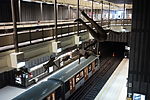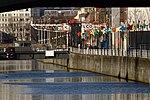Molenbeek-Saint-Jean Municipal Hall
Belgian building and structure stubsBuildings and structures in BrusselsCity and town halls in BelgiumCommons category link is locally definedGovernment buildings completed in 1886 ... and 3 more
Molenbeek-Saint-JeanProtected heritage sites in BrusselsUse British English from July 2023

The Municipal Hall (French: Hôtel communal, Dutch: Gemeentehuis) of Molenbeek-Saint-Jean is the municipal hall building and the seat of that municipality of Brussels, Belgium. Designed by the architect Jean-Baptiste Janssens and completed in 1886, it is located at 20, rue du Comte de Flandre/Graaf van Vlaanderenstraat. This site is served by Comte de Flandre/Graaf van Vlaanderen metro station on line 5 of the Brussels Metro.
Excerpt from the Wikipedia article Molenbeek-Saint-Jean Municipal Hall (License: CC BY-SA 3.0, Authors, Images).Molenbeek-Saint-Jean Municipal Hall
Rue du Comte de Flandre - Graaf van Vlaanderenstraat,
Geographical coordinates (GPS) Address Website Nearby Places Show on map
Geographical coordinates (GPS)
| Latitude | Longitude |
|---|---|
| N 50.8552 ° | E 4.3387 ° |
Address
Maison communale de Molenbeek-Saint-Jean - Gemeentehuis van Sint-Jans-Molenbeek
Rue du Comte de Flandre - Graaf van Vlaanderenstraat 20
1080
Belgium
Open on Google Maps









